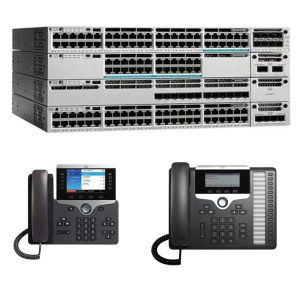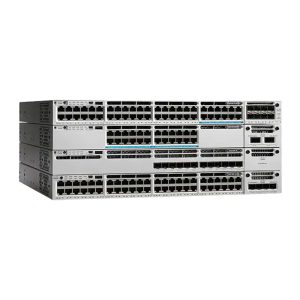The Cisco Catalyst 9300 and Catalyst 9500 are both series of enterprise-level switches designed for use in enterprise campus networks. The 9300 series is designed for use as access switches, while the 9500 series is intended for use as core and aggregation switches. Both series support Cisco’s DNA software-defined networking (SDN) platform and offer advanced security and network management features. The 9500 series also offers higher performance and scalability, with support for faster speeds and more switching capacity. Both series are also designed to be energy-efficient and easy to manage, with support for automated provisioning and troubleshooting.
The Cisco Catalyst 9300 and Catalyst 9500 are both high-end, enterprise-grade switches that are designed for use in large and complex networks. However, there are some key differences between the two:
- Switching Capacity: The Catalyst 9500 switches have higher switching capacity than 9300 switches, up to 2.56 Tbps.
- Power over Ethernet: Both switches support power-over-ethernet on most models. However, the Catalyst 9300 switches have some options where PoE isn’t available. The Catalyst 9500 on the other hand can deliver as high as 60W per port PoE depending on model.
- Modules: The Catalyst 9300 switches support a maximum of 40GE modular support similar to the Catalyst 9500 switches that also support modules with up to 40GE support. The difference here is that the 9300 offer 9 different modules whereas the 9500 series has only 2 options for network modules.
- Layer 3 capabilities: The Catalyst 9300 is a layer 3 switch and it supports advanced routing protocols such as OSPF, EIGRP, and BGP. The Catalyst 9500 is a modular switch and it supports not only routing protocols but also MPLS, VPN, IPv6, and other advanced features.
- Security: The Catalyst 9500 has more advanced security features like TrustSec, which allows for secure segmentation of the network, and Cisco DNA Center, which provides a centralized management and automation of the network.
Both switches are designed to handle high-bandwidth, high-density environments, but the Catalyst 9500 is geared more towards large enterprise networks with advanced routing and security requirements.
Switching Capacity
The switching capacity of a switch refers to the maximum amount of data that the switch can process and forward at any given time. It is typically measured in bits per second (bps) or packets per second (pps). The switching capacity of a switch determines the maximum amount of traffic that it can handle without experiencing performance bottlenecks or packet loss. A switch with a higher switching capacity will be able to handle more traffic and support more devices than a switch with a lower switching capacity. The switching capacity of a switch can be affected by factors such as the number and type of ports, the type of switching technology used, and the speed of the processors and memory in the switch.
This is an area where the Catalyst 9500 is far superior to the Catalyst 9300 series switches. The 9300 catalyst switches have a maximum switching capacity of up to 2000 Gbps and 3000 Gbps with stacking. The forwarding rate maxes out at 1488 Mpps that can be increased to 2232 Mpps with stacking.
The Catalyst 9500 delivers up to 9.2 Tbps with a forwarding rate going as high as 8 Bpps for the top end models in the Catalyst 9500 series.
Power Over Ethernet
Since both switches support PoE, the need for having redundant power supplies is inevitable. Both the Catalyst 9300 and Catalyst 9500 support PoE with a few exceptions. The PoE support available on the Catalyst 9500 series switches can go as high as 60W PoE per port on some models.
This clearly means lesser cabling since you get the ability to power up devices without them being plugged in directly to a power source. Not only does this reduce the burden on the network teams but also subtracts from the cost charts of an organization building a new network.
An important part to be noted here is that the PoE capacities for both Catalyst 9300 and Catalyst 9500 are variable with the options of redundant power supplies. While using redundant power supplies for both series, one may be able to increase PoE allocation per port and for the entire network. This further helps with keeping your network capacities variable in terms of the need to power newly added devices.
Modules
As both the Catalyst 9300 and Catalyst 9500 are modular network switches, one huge benefit that comes along is the ability to increase number of ports as per the need of the network. This is an area where the Catalyst 9300 offers greater flexibility by offering more options than the Catalyst 9500 series.
For the Catalyst 9300 series the modules available can be 2, 4 or 8 ports. For the Catalyst 9500 series, however, the options are only either a 2-port module or an 8-port module.
The list of available network modules for the Catalyst 9300 series is given below.
Network module | Details |
Catalyst 9300X 8x 10G/1G Multigigabit Network Module | |
Catalyst 9300X 8x 25G/10G/1G Network Module | |
Catalyst 9300X 2x 100G/40G Network Module | |
Catalyst 9300X 4x 100G/40G Network Module | |
Catalyst 9300 Series 4x 1G Network Module | |
Catalyst 9300 Series 4x Multigigabit Network Module | |
Catalyst 9300 Series 8x 10G/1G Network Module | |
Catalyst 9300 Series 2x 40G Network Module | |
Catalyst 9300 Series 2x 25G/10G/1G Network Module |
We have obtained this list from another post on website specifically for the Catalyst 9300 series. Here is the link.
Modules for Catalyst 9300 Series

The available options for the Catalyst 9500 are given below.
Network module | Description |
Cisco Catalyst 9500 Series Network Module 8-port 1/10 Gigabit Ethernet with SFP/SFP+ | |
Cisco Catalyst 9500 Series Network Module 2-port 40 Gigabit Ethernet with QSFP+ |
From the above options available for both series, one can easily make the network flexible in terms of needed output from the network switches.
Modules for Catalyst 9500 series

Layer-3 Capabilities
Both the Catalyst 9300 and Catalyst 9500 are layer 3 capable switches with a few minor differences. Since most of the networking people know that layer 3 has a bifurcated focus between switching and routing, to expect layer 3 abilities from the catalyst 9k switches isn’t much of an ask. Both series are quite capable in their routing abilities in addition to switching tasks.
The Catalyst 9300 series support both switching and routing features, it can be used as an access switch and also it can be used as a distribution switch in enterprise networks. The 9300 series supports advanced security features such as Cisco TrustSec, Cisco Identity Services Engine, and Cisco Stealthwatch. It also supports Cisco DNA Center for network management and automation.
Cisco Catalyst 9500 Series is a high-performance, fixed-configuration, modular switch that is part of the Cisco Catalyst 9000 Family. It is designed for enterprise and service provider networks, and is capable of switching and routing. The 9500 series offers a range of models with varying port densities and capabilities, making it suitable for deployment at the enterprise campus, data center, and service provider edge. The 9500 series supports advanced security features such as Cisco TrustSec, Cisco Identity Services Engine, and Cisco Stealthwatch. It also supports Cisco DNA Center for network management and automation. The 9500 series can be used as a core switch, aggregation switch and also as a distribution switch. It also supports 40/100Gbps ports to provide high-speed connectivity.
In brief, if both switching (Layer 2) and routing (Layer 3) is required, then both the Catalyst 9300 and Catalyst 9500 will deliver as needed.
Security
Both the Cisco Catalyst 9300 and Catalyst 9500 series switches have a range of advanced security features that help protect networks from threats. Some of the key security features of these switches include:
- Cisco TrustSec: This is a comprehensive security solution that enables the creation of secure domains and the enforcement of security policies across the network.
- Cisco Identity Services Engine (ISE): This is a network access control solution that allows for the enforcement of security policies based on user identity.
- Cisco Stealthwatch: This is a network behavior analytics solution that helps detect and respond to network threats.
- Access control list (ACL): This feature allows administrators to define and implement access control policies on the switch, to restrict access to specific network resources.
- IEEE 802.1x: This is an industry standard for port-based network access control, which allows the switch to authenticate users before granting network access.
- Cisco FirePOWER: This is a next-gen firewall solution that helps to protect against advanced threats.
- Encrypted Traffic Analytics (ETA): This feature allows the switch to detect malware and other threats in encrypted traffic.
- Advanced Malware Protection (AMP): This feature uses Cisco Talos threat intelligence to detect and block malware and other threats.
- Secure Boot: This feature ensures that the switch runs only firmware that is digitally signed by Cisco, preventing malicious firmware from being loaded.
- Secure Shell (SSH) and Secure Copy Protocol (SCP): This feature allows for secure remote management of the switch, and prevents unauthorized access.
It’s worth noting that the security features available on Catalyst 9500 series are more advanced and complete than 9300 series, as the 9500 series is designed to be used in service provider and enterprise networks where security is a critical aspect.
To read more about the individual series please use the below links to their relevant datasheets.
CISCO Catalyst 9300 Datasheet
CISCO Catalyst 9500 Datasheet
Also below is the link to the youtube video we have put up on our channel in case you prefer that.














